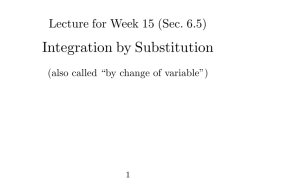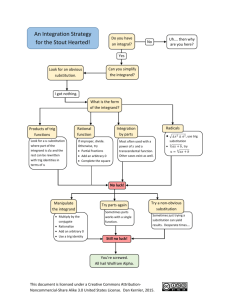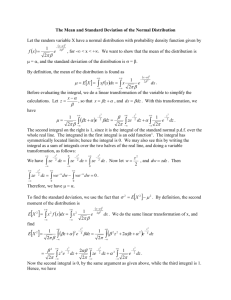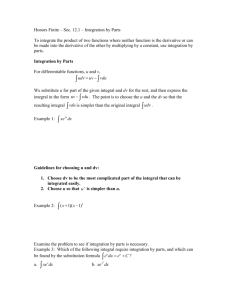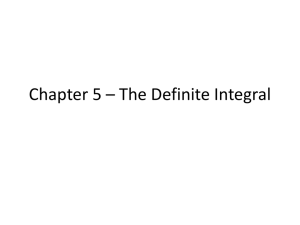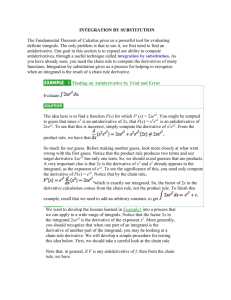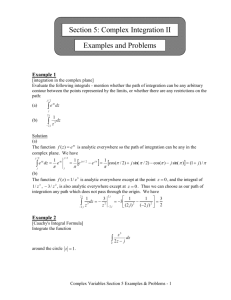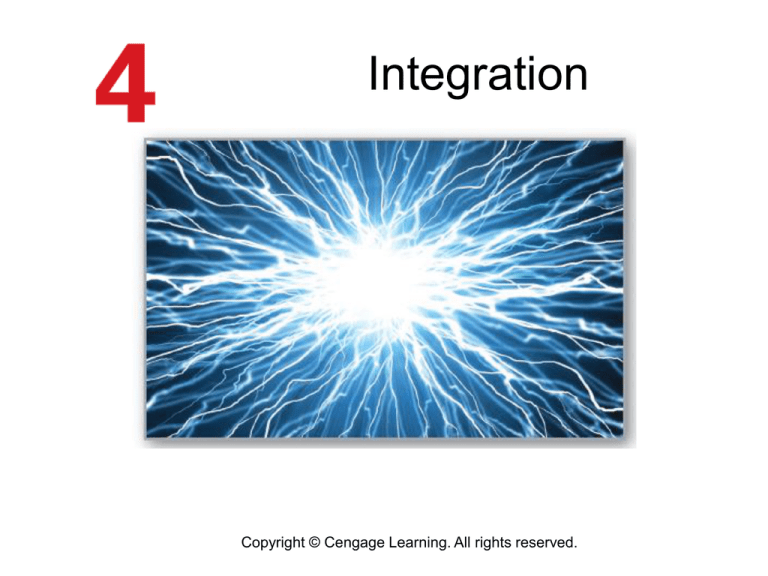
Integration
Copyright © Cengage Learning. All rights reserved.
4.5
Integration by Substitution
Copyright © Cengage Learning. All rights reserved.
Objectives
Use pattern recognition to find an indefinite integral.
Use a change of variables to find an indefinite integral.
Use the General Power Rule for Integration to find an
indefinite integral.
Use a change of variables to evaluate a definite integral.
Evaluate a definite integral involving an even or odd
function.
3
Pattern Recognition
4
Pattern Recognition
In this section you will study techniques for integrating
composite functions.
The discussion is split into two parts—pattern recognition
and change of variables. Both techniques involve a
u-substitution.
With pattern recognition, you perform the substitution
mentally, and with change of variables, you write the
substitution steps.
The role of substitution in integration is comparable to the
role of the Chain Rule in differentiation.
5
Pattern Recognition
Recall that for differentiable functions given by y = F(u) and
u = g(x), the Chain Rule states that
From the definition of an antiderivative, it follows that
6
Pattern Recognition
These results are summarized in the following theorem.
7
Pattern Recognition
Example 1 shows how to apply Theorem 4.13 directly, by
recognizing the presence of f(g(x)) and g'(x).
Note that the composite function in the integrand has an
outside function f and an inside function g.
Moreover, the derivative g'(x) is present as a factor of the
integrand.
8
Example 1 – Recognizing the f(g(x))g'(x) Pattern
Find
Solution:
Letting g(x) = x2 + 1, you obtain
g'(x) = 2x
and
f(g(x)) = f(x2 + 1) = (x2 + 1)2.
From this, you can recognize that the integrand follows the
f(g(x))g'(x) pattern.
9
Example 1 – Solution
cont’d
Using the Power Rule for Integration and Theorem 4.13,
you can write
Try using the Chain Rule to check that the derivative of
+ C is the integrand of the original integral.
10
Pattern Recognition
The integrand in Example 1 fits the f(g(x))g'(x) pattern
exactly—you only had to recognize the pattern.
You can extend this technique considerably with the
Constant Multiple Rule
Many integrands contain the essential part (the variable part)
of g'(x) but are missing a constant multiple.
In such cases, you can multiply and divide by the necessary
constant multiple, as shown in Example 3.
11
Example 3 – Multiplying and Dividing by a Constant
Find
Solution:
This is similar to the integral given in Example 1, except that
the integrand is missing a factor of 2.
Recognizing that 2x is the derivative of x2 + 1, you can let
g(x) = x2 + 1 and supply the 2x as follows.
12
Change of Variables
13
Change of Variables
With a formal change of variables, you completely rewrite
the integral in terms of u and du (or any other convenient
variable).
Although this procedure can involve more written steps than
the pattern recognition illustrated in Examples 1 and 3, it is
useful for complicated integrands.
The change of variables technique uses the Leibniz notation
for the differential. That is, if u = g(x), then du = g'(x)dx, and
the integral in Theorem 4.13 takes the form
14
Example 4 – Change of Variables
Find
Solution:
First, let u be the inner function, u = 2x – 1.
Then calculate the differential du to be du = 2dx.
Now, using
obtain
and
substitute to
15
Example 4 – Solution
cont’d
16
Change of Variables
The steps used for integration by substitution are
summarized in the following guidelines.
17
The General Power Rule for
Integration
18
The General Power Rule for Integration
One of the most common u-substitutions involves quantities
in the integrand that are raised to a power.
Because of the importance of this type of substitution, it is
given a special name—the General Power Rule for
Integration.
19
Example 7 – Substitution and the General Power Rule
20
Example 7 – Substitution and the General Power Rule
cont’d
21
Change of Variables for Definite
Integrals
22
Change of Variables for Definite Integrals
When using u-substitution with a definite integral, it is often
convenient to determine the limits of integration for the
variable u rather than to convert the antiderivative back to the
variable x and evaluate at the original limits.
This change of variables is stated explicitly in the next
theorem.
23
Example 8 – Change of Variables
Evaluate
Solution:
To evaluate this integral, let u = x2 + 1.
Then, you obtain
Before substituting, determine the new upper and lower limits
of integration.
24
Example 8 – Solution
cont’d
Now, you can substitute to obtain
25
Example 8 – Solution
cont’d
Notice that you obtain the same result when you rewrite the
antiderivative
in terms of the variable x and evaluate
the definite integral at the original limits of integration, as
shown below.
26
Integration of Even and Odd
Functions
27
Integration of Even and Odd Functions
Even with a change of variables, integration can be difficult.
Occasionally, you can simplify the evaluation of a definite
integral over an interval that is symmetric about the y-axis or
about the origin by recognizing the integrand to be an even or
odd function (see Figure 4.40).
Figure 4.40
28
Integration of Even and Odd Functions
29
Example 10 – Integration of an Odd Function
Evaluate
Solution:
Letting f(x) = sin3x cos x + sin x cos x produces
f(–x) = sin3(–x) cos (–x) + sin (–x) cos (–x)
= –sin3x cos x – sin x cos x = –f(x).
30
Example 10 – Solution
cont’d
So, f is an odd function, and because f is symmetric about
the origin over [–π/2, π/2], you can apply Theorem 4.16 to
conclude that
Figure 4.41
31
Example 10 – Solution
cont’d
From Figure 4.41, you can see that the two regions on either
side of the y-axis have the same area. However, because
one lies below the x-axis and one lies above it, integration
produces a cancellation effect.
Figure 4.41
32



